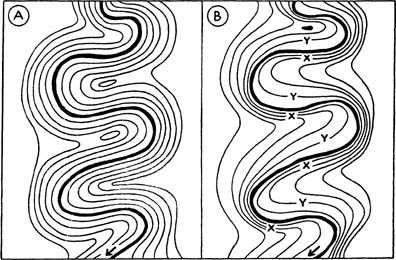
My mom used to work for the Environmental Protection Agency. She rode the bus downtown every workday from where she lived in the mountains outside of Denver. A golden-hearted woman, she believes in the EPA’s mission, which is protection. She saw her agency’s job as preventing the water we drink and the air we breathe from becoming unhealthy, which would degrade the existence of every living thing, including us. Those are my words. She’d say it was keeping our lives and the world good.
This was years ago and I was in my late twenties, she in her forties. I ran a fly by night river outfit in the desert of southeast Utah and sometimes she’d come on trips. We were with a group of mostly geologists for a week on the Green River and I had this hydrology trick I wanted to show them. It’s where you fill a five-gallon bucket with river water, carry it up a cut bank of a beach, and pour it into the damp sand where you watch a stream run back to the river. It carves a channel, setting up meanders, building cliffs on one side, tearing them down on the other, all six or seven inches deep. It’s a perfect miniature, an analog landscape. The damage left behind would be a winding rivulet that hardly anyone would notice. Like my mom, I prefer to impact my environment as little as possible, while I do like engaging with it.
We tied off in the mouth of a side canyon boxed in with cliffs and a steep beach out front, a good place for this hydrology experiment. When we got out and stretched our legs, we found that the river had pushed up sand and dammed the mouth of this incoming drainage. A body of water had gathered behind it, a long, narrow pond of driftwood and drowned willows.
A lightbulb went off in my head.
My mom, from the EPA, was opposed to my idea from the start. The geologists, however, were all behind me. I made a small incision in this natural dam and let some water through. The pond behind it was a muddy mess anyway, and it would breed mosquitoes if it lasted long, which it wouldn’t, a week or two before spring runoff would sink this place and rearrange everything.
The next ten minutes were a fluvial geomorphologist’s dream, a lesson in process and form. The little stream worked its way down the slope carving a negligible channel where I ran alongside saying here you can see the counter-swirling you get in Antelope Canyon in Arizona, and here are the goosenecks of the San Juan River near the Four Corners. Currents skirted faster on the outside bends, causing the goosenecks to migrate where water went from laminar to knots of turbulence and back to laminar, each change recorded in the substrate.
My mom stood with her arms folded on the other side of the beach. Water increased in speed and volume. Sand at the head began to topple. We pushed sand back into the gap to close it, but it wouldn’t close. We gathered driftwood and rocks, straining our knowledge of engineering, which failed as water threaded through our slapdash repair job. The dam opened and the pond drained back into the Green River.
I stood in the antlered remains of our playtime. There was now a gorge you could stand in. I looked over at my mom. Her arms were still crossed.
We left that beach a frothy mess. Anything we did to pick it up made it worse. Damage done, take your hands off, and carry the story for the rest of your life.
Last week, the US Supreme Court made a pointed decision reducing the power of the EPA by limiting the scope of the Clean Air Act, preventing the EPA from making climate change decisions. The vote was 6-3. Reading the dissenting opinion, I think of my mom. Justice Elena Kagan wrote, “The Court appoints itself—instead of Congress or the expert agency—the decision maker on climate policy. I cannot think of many things more frightening.“
The three dissenting justices as well as the whole of the EPA, and my mom, are standing on the other side of the beach right now, arms folded, and the water is coming through.
This is perfect. I wish more people understood.
It’s only been in recent years that I’ve met people who sweat bullets at the partisan mix of the Supreme Court. When I ask why party politics has anything to do with the justices on the Court, these same people admit “it shouldn’t be that way.” But it is. Partisan politics is the most destructive element in our society. And Craig, you’ve opened my eyes to yet another way this Court can damage our world.
Calls to mind a long-term creative project I started some years back: “Changing the Course of Nature” http://neoscenes.net/blog/category/performances/changing-the-course-of-nature — initially sourced in what kids do around creeks and such. And what humans do to their proximal (and distal!) environs: change them by their mere presence along with un/conscious manipulations.
I recall having a sad dinner w/ some acquaintances who were scientists at the Denver EPA a couple days after the 2016 election.